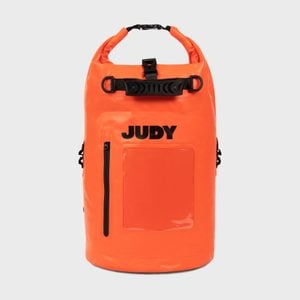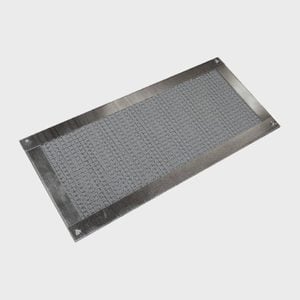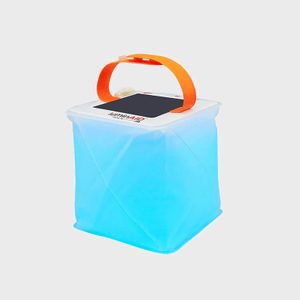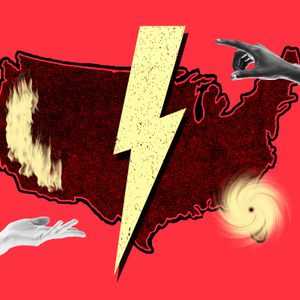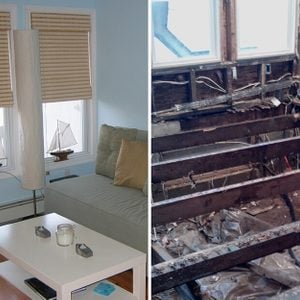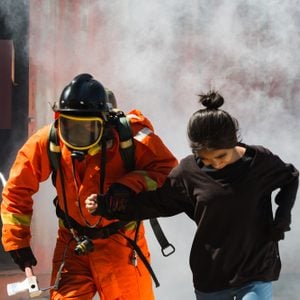What Is a Wildfire, and How Do You Prepare for One?
Updated: Aug. 09, 2023
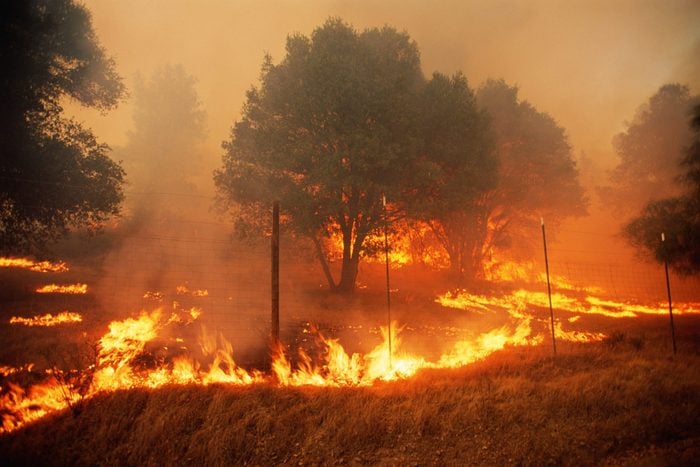
Knowledge is your best defense against a wildfire—and this information could save your life
It’s not your imagination: Wildfires have become more prevalent in recent years. In the United States, an average of 61,289 occur annually, impacting around 7.4 million acres every year, and experts say that they will likely increase in 2023 and beyond. According to the National Oceanic and Atmospheric Association (NOAA) and other experts, this is a direct result of climate change and the drier conditions resulting from it. Of course, not all fires are wildfires. So, what is a wildfire, exactly, and what do you need to know to protect yourself?
We’ll get into the details below, but the first thing you need to know is that they can affect a variety of areas. The second thing? They spread fast. That’s why it’s so important to be prepared. Some of the protocols are the same as those you’d follow when preparing for a hurricane and a tornado, but others are wildfire-specific to keep you safe from the potentially deadly flames and smoke. While we hope that you’ll never get caught in a wildfire, this essential information will help protect you and your home, just in case. Wondering how to help others when something like this happens? Here’s what you can do to help after any natural disaster.
Get Reader’s Digest’s Read Up newsletter for more advice, humor, cleaning, travel, tech and fun facts all week long.
What is a wildfire?
A wildfire describes any fire that is unplanned, uncontrolled and/or unpredictable in a natural area where there is combustible vegetation. It is also sometimes called a rural fire, wildland fire, bush fire or forest fire. And while childhood memories of Smokey the Bear may make you think about them raging in a forest, they can happen anywhere.
“A wildfire can happen in any type of landscape,” says Ivan O’Neill, a wildfire mitigation specialist and the co-founder of Madronus Wildfire Defense. “Grassland wildfires can often be very destructive because dry grasses flash burn and spread fire across a large distance quickly, as we saw in the 2021 Marshall Fire in Boulder County, Colorado, that destroyed over 1,000 structures.”
But wildfires shouldn’t be confused with prescribed fires, which are planned and intentionally ignited. Prescribed fires are set and controlled by federal or state land managers with the goal of reestablishing an area’s natural balance in ecosystems that are fire-dependent, says Nikole Pearson, founder and president of Peak Science Communications. “A wildland fire is an overarching term that includes both prescribed fire and wildfire,” she adds.
What causes a wildfire?
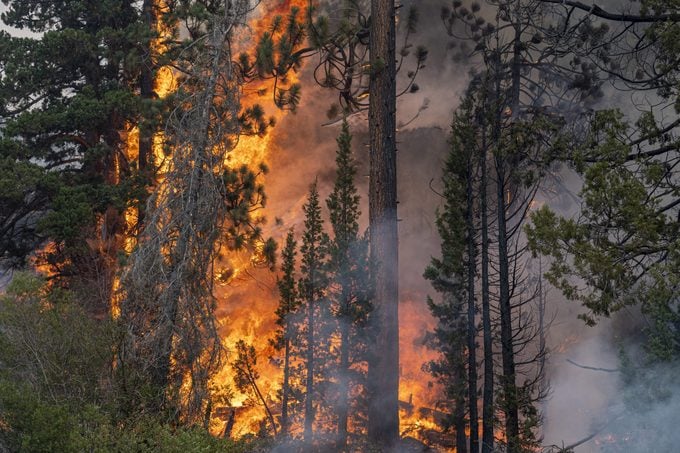
In short, anything that causes a spark. And while some wildfires are started intentionally, the majority are accidental. “Ignitions come from many sources, like an overheated car pulling into a grass field, loose trailer chains sparking when they strike the road, campfires, unsafe chimneys or someone mowing their field on a hot, dry day,” O’Neill tells Reader’s Digest. Mother Nature can also play a role, with lightning strikes and wind that knocks down power lines, both of which can set off uncontrollable blazes.
But what turns a fire into a wildfire? “Wildfires require the alignment of a number of factors, including temperature, humidity and the lack of moisture in fuels such as trees, shrubs, grasses and forest debris,” according to NOAA. O’Neill adds that wildfires tend to be more dangerous when the vegetation is dry, the relative humidity is below 20%, temperatures are in the 50- to 70-degree range and winds are above 15 to 20 miles per hour. Two of the most recent wildfires, which burned more than 127,000 acres in Tennessee and Oregon, were exacerbated by dry and breezy weather conditions.
Climate change is also an overarching factor since our warming earth causes drier conditions—and that provides the perfect environment for a wildfire. Wildfires are a particular risk in areas that are drier than usual.
Can wildfires be prevented?
Yes and no. The overwhelming majority of wildfires in the United States—as many as 85%—are caused by people, according to the National Park Service. It is essential for people to be aware of how their actions could start a fire, whether that’s leaving a campfire unattended or improperly discarding a cigarette. As with so many other things, awareness truly is the first step. Still, other human causes are out of our control, such as equipment use or malfunctions. And then there are the nonhuman causes rooted in nature. Either way, it’s easy for a fire in the right conditions to spread fast.
That’s why experts say that the main focus of wildfire prevention should be mitigation. “Ignitions cannot really be prevented, though it’s important to raise awareness and minimize them,” O’Neill says. “Wildfires [also] cannot really be prevented, but they can be made less severe and destructive.”
One way to do that, according to O’Neill? By having specialists introduce low-intensity fires to reduce some of the “fuel” (aka vegetation) that fires feed on. This also helps the ecosystem and even the wildlife that lives in it. “Most forests in the United States are fire-adapted, meaning that trees and plant communities evolved with regular fires, mostly lit by Native Americans every one to 15 years,” O’Neill says. “In California, the largest trees on the plant—sequoias—need fire to open their cones so their seeds can germinate.”
But this technique was phased out in the 1930s by the U.S. Forest Service, and as a result, trees grow wild and are more densely packed. “This stresses them, especially in times of drought, and leads to bark beetle outbreaks that kill trees and create lots of dry tinder on the landscape,” O’Neill explains. “As low-severity fire was removed from the landscape, more trees and shrubs survived that would have been thinned naturally by the flames. This leads to more fuel in our forests today than historically.”
How to prepare for a wildfire
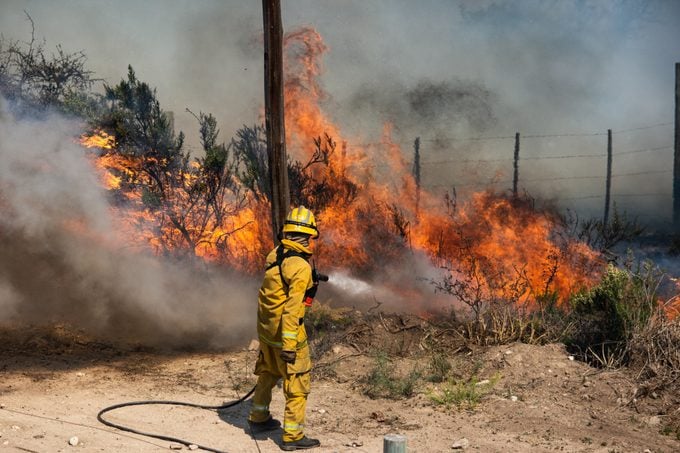
Before you can effectively prepare, it’s crucial to understand how wildfires operate. “Many think wildfires destroy homes because a wall of flames moves across the landscape,” O’Neill says. “Actually, it’s millions of tiny embers being cast up to 2 miles ahead of the flame front, blown by wind, and the heat energy of the fire finding its way into nooks, crannies and things we all have around our homes and businesses that destroys most of them.”
Now that you know what a wildfire is, here’s how you can protect your home and your family.
Build defensible spaces and harden your home
Defensible space is a buffer between your home and the grass, trees and bushes surrounding it. Because a wildfire feeds off this vegetation when it’s dry, this space will help keep the flames away from your home. Home hardening, on the other hand, refers to specific types of construction that reduce the vulnerability of your home to embers, heat and fire. That might entail using nonflammable building materials, such as concrete, stucco and brick, instead of wood framing.
“Most homes need $10,000 to $20,000 in home-hardening upgrades and defensive space work to mitigate wildfire risk,” O’Neill explains. But this type of home-improvement project is worth it: Research shows that these upgrades reduce a home’s chance of being destroyed in a wildfire by up to 75%.
Create an evacuation plan
Families should go over an evacuation plan and practice it—especially if they have kids—well before an emergency actually occurs. “Knowing when to leave and being able to go quickly is crucial during an evacuation scenario,” Pearson says. First, set a meetup destination for all family members. Then “plan your primary and alternative evacuation route, and assemble emergency supplies and store them where you can get to them quickly.”
What should go in your wildfire emergency supply kit? According to experts, it should include:
- Face masks
- 100% cotton cover-ups (like coveralls or a blanket) to protect skin and hair from embers
- Leather gloves to protect hands
- Three days’ worth of nonperishable food and three gallons of water per person
- A map marked with at least two evacuation routes
- Medications
- An extra pair of glasses and contact lenses (if you wear them)
- A change of clothing
- Credit cards, cash and an extra set of car keys
- First-aid kit
- Flashlight
- Battery-powered radio and extra batteries
- Sanitation supplies
- Copies of important documents
- Chargers for devices
- Pet food and water
You can buy a pretty comprehensive go-bag, which you can then further customize, or you can assemble everything yourself. The key is to have it fully packed and ready to go so you don’t have to worry about it in an emergency. Beyond that, if time allows, Ready for Wildfire also suggests grabbing easily carried valuables, sentimental family photos and personal computer information (on hard drives and disks).
Download emergency apps
The Red Cross Emergency app will send you emergency alerts that are critical to your location (namely, when to evacuate and where to), while the FEMA app provides a list of local shelters accepting people.
You shouldn’t rely on emergency alert broadcast systems because by the time the alert gets to your TV or radio, it may already be too late. “Local officials must notify this national system [for it to interrupt your TV or radio],” says Pearson. “And, as is often the case between local and federal governments, communication breakdown happens often and quickly.”
Keep the area surrounding your home free of fire hazards
Fire hazards in your home aren’t the only things you need to worry about. “Clear the area immediately around your home of all fuels, plants and hazards (zero to 5 feet), including wood piles, fuel storage tanks, grills, furniture and flammable doormats,” O’Neill says. He adds that wood fences will also catch fire when debris and embers are blown against them … then carry them right to your house as it burns. That’s why he suggests removing and replacing all sections of a fence within 6 to 10 feet of your home with stone or metal.
And yes, you may want to get rid of the plants directly next to your house. “Many of us have bark mulch and herbaceous shrubs right next to the home,” O’Neill says, “but these can often ignite.” He suggests removing them entirely or replacing them with something less flammable, such as rocks, pavers or short, herbaceous plants that are well irrigated (think succulents, cacti or yuccas). Pro tip: Stay away from overly fragrant plants since they tend to burn more easily.
Rake dead leaves, and properly dispose of them
Dry, dead leaves, as well as pine needles and dry grass, are extremely flammable. But when discarding leaves, do not store them near the house or by a woodpile—even if they are already bagged. It’s important to get rid of these fire hazards quickly or make sure they are far enough from your home, any wood piles or other structures.
To ensure your bagged-up leaves get taken away promptly, rake according to your town’s local leaf-pickup schedule. Most municipalities have several leaf-designated pickups per season.
Dispose of dead tree limbs
Similar to dry or bagged leaves, dead tree limbs are dry, which means they, too, can ignite and catch fire quickly. If you have any hanging from trees or laying in your yard, dispose of them ASAP. The same rule applies when disposing of dead tree limbs: Do not store them close to the house.
Invest in fire-rated vents
O’Neill advises replacing or covering all vents, including the crawl space, attic and roof, with a fire-rated vent like a Vulcan vent. “Or screen them in with at least 1/8-inch wire mesh,” he says, though he notes that 1/16-inch wire mesh is better. “Enclosed eaves protect vulnerable rafters from wind-blown embers getting into the attic space and prevent any heat rising from burning materials below them from getting trapped in the eaves and igniting the roof deck from below.”
Upgrade your exterior with noncombustible siding
O’Neill advises having at least 6 inches of vertical clearance between any combustible siding—including wood, plywood, vinyl or other plastics—and the ground. “This is so that embers and debris blown against a structure during a wildfire don’t smolder and ignite your siding,” he explains.
You can replace the lower 6 inches of siding with a noncombustible product like fiber cement or install a galvanized metal flashing.
Make sure gutters are made of metal
Replace vinyl or plastic gutters, which can easily catch fire, with metal gutters. “Install metal gutter covers to reduce leaf litter and windblown debris,” says O’Neill. “This will ensure that embers don’t ignite in them and spread fire to your home.” Pro tip: Don’t pressure-wash gutters; it can damage them or pull them off your house.
More wildfire preparation tips
- Replace single-pane windows, especially those facing prevailing/reverse-prevailing wind directions, with double-paned windows. Make sure at least one pane is made from tempered glass (though two is better).
- Install weather stripping around all doors and garage doors. Eliminate gaps larger than 1/8 inch so that embers can’t enter your home.
- Patch or cover any holes in siding, doors or garage doors. If you can see light when looking from the inside, embers can get in.
- Clear the space underneath decks, and screen them in if they’re less than two feet high.
- Clear debris in the gutters or on the roof.
- Remove all dead/dying vegetation within 100 feet of your home (prioritizing the first 3 feet).
- Mow all grass (no later than May/June in California) to 4 inches.
- Remove tree limbs up to at least 6 feet (10 to 15 feet is better) or 1/3 the height of the tree if it’s small.
- Space trees so there’s at least 15 feet between canopies. However, if you’re on a slope that’s more than 40%, increase the distance between canopies to 30 feet.
- Install a home-fire sprinkler system, or install sprinklers around your home.
Sources:
- Congressional Research Service: “Wildfire Statistics”
- NOAA: “Wildfire Climate Connection”
- Ivan O’Neill, co-founder of Madronus Wildfire Defense, an NFPA-certified wildfire mitigation specialist and an NWCG Wildland Firefighter Type 2
- Nikole Pearson, founder and president of Peak Science Communications
- Center for Climate and Energy Solutions: “Extreme Weather and Climate Change”
- Forest History Society: “U.S. Forest Service Fire Suppression”
- Cal Fire: “Defensible Space”
- National Association of Insurance Commissioners: “Application of Wildfire Mitigation to Insured Property Exposure”
- Cal Fire: “Assemble an Emergency Supply Kit”

